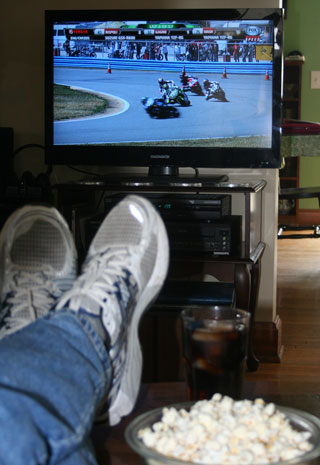
Watching the 72nd Daytona 200. It ain’t what it used to be.
In 1995, World Superbike legend Carl Fogarty caused an international incident in motorcycle terms by complaining about Daytona International Speedway. Today, there’s no worry about that happening, just because no world-caliber rider would consider racing in the once-proud Daytona 200. Even the best racers at the national level aren’t on the Daytona 200 grid.
What was once among the most important motorcycle races of the year, one that attracted grand prix riders for one-off performances, and even 18 years ago could draw a reluctant world champion like Fogarty to its borderline dangerous track, is now a race mostly for up-and-coming youngsters and veterans on the downhill slope of their careers. The grid is half the size of what it was just a decade ago. Attendance: pathetic. TV coverage: hanging by a thread.
No, this decline is not exactly news, as someone pointed out to me lately. But it has been so steep and fast, it’s easy to forget just how much has been lost so quickly. At 72, the Daytona 200 looks old for its age.
Remember the grids at Daytona that were so full the riders went off in two waves? If you’re old enough, remember when Giacomo Agostini, the all-time grand prix win record holder, came to the speedway to win the Daytona 200? Can you imagine the modern equivalent of Agostini, Valentino Rossi, racing at Daytona? The only way Rossi will ever compete at Daytona International Speedway is if he decides to do some sports car racing after he retires from motorcycling and gets a ride in the 24 Hours of Daytona. In the past, a manufacturer might encourage one of its world-class riders to compete in a one-off ride at Daytona. Today, they’d almost certainly discourage it, if a rider were crazy enough to consider the idea. Too much risk, no reward.
So what happened? There are so many reasons, blame could be spread thick on everyone involved and there would still be more left over.
First and foremost, in my opinion, is that the Daytona International Speedway is a lousy place for a motorcycle race. If there hadn’t been a 200-mile race at Daytona 71 previous times, nobody would consider trying to start one there today. The infield track is uninteresting and the banking is not very safe. That’s why the 200 was switched to 600-class bikes from the literbikes, to try to preserve it by keeping speeds in check.
The Daytona 200 is the motorcycle racing version of that Vietnam War saying: We had to destroy the village to save it. We had to destroy the Daytona 200 to save it. We had to keep running on a lousy track, we had to run it with second-level bikes, we had to accept that the best riders in the country (forget the best riders in the world) aren’t on the grid just so we could line up one more time for something labeled the Daytona 200 and pretend we’re still carrying on a grand tradition.
I hate to see traditions vanish as much as the average fan, but at what cost? As I watched the checkered flag wave the 72nd Daytona 200 into the record books, I had to ask myself an uncomfortable question: At what point are we sullying the greatness that once was by continuing to run a thin farce of what used to be? At what point would the historic races of the past be better left untouched in history, instead of dragged down by today’s pale imitations? Have we saved the village or destroyed it?
Postscript: None of the above is meant to belittle a dominant performance by Cameron Beaubier, who is well on his way to proving he is the talented and heady young racer he has been reputed to be. I expect he may well achieve greatness. But if he does, 20 years from now when his career is being viewed mostly in the rear view mirror, a win at Daytona will be a very small part of what earned him greatness. That level of respect now has to be won elsewhere.
